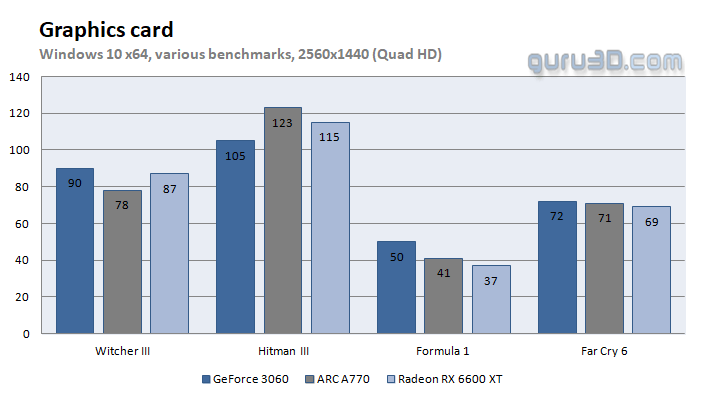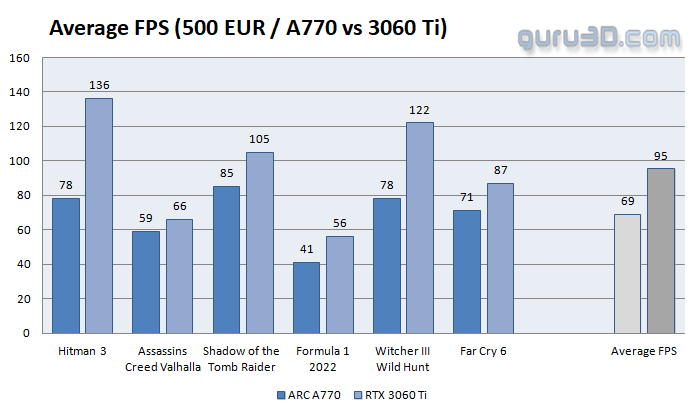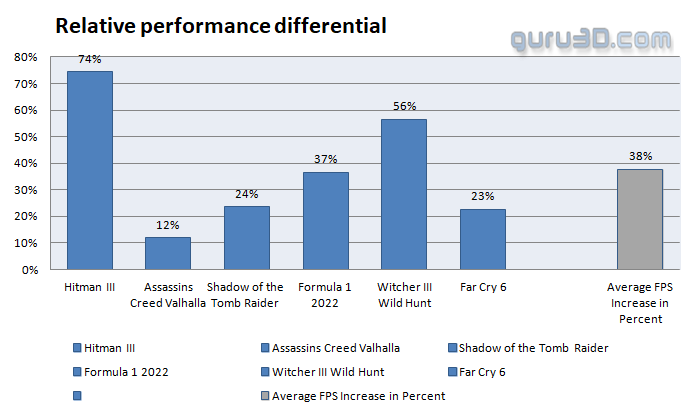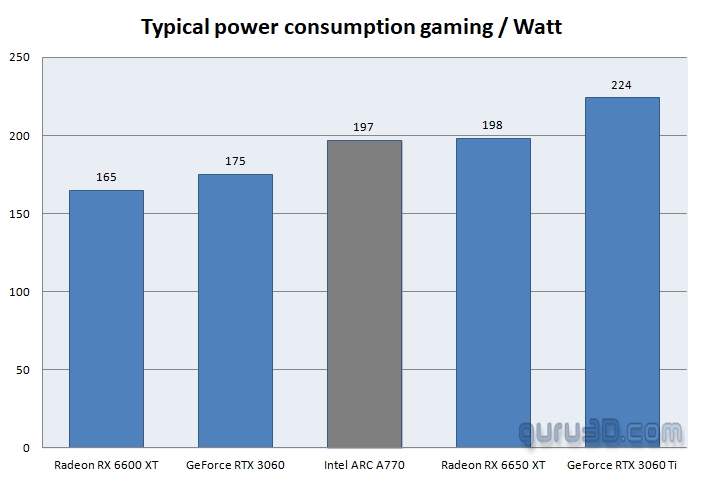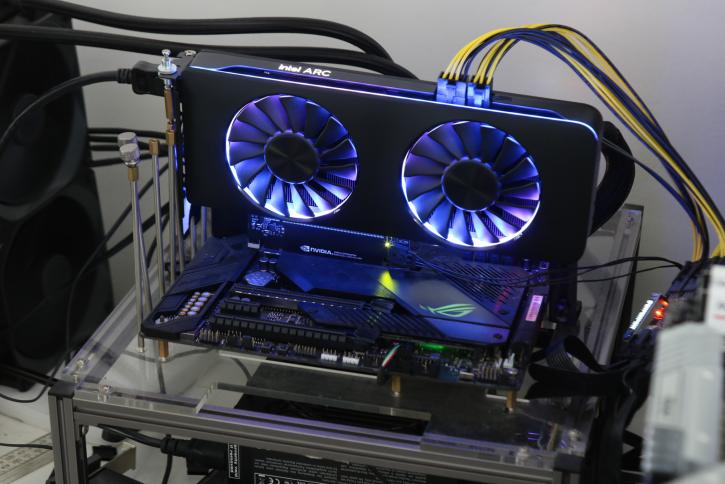Final words and conclusion
Final words
Granted, it was a letdown that we could not share this review in the first round. However, with that delay also came a few new developments. The first is stability. Yes, we have seen some minor stability issues, but nothing extreme. Secondly, we're a few driver builds away from the initial review round, and it seems that Intel has been hard at work optimizing game and especially synthetic titles. We're seeing the great potential with DX12 titles. If we focus on synthetic benchmarks, here's where Intel shines. Unfortunately, where it matters, it's winning and can show losses. In one game you'll see RTX 3060 Tu performance, in the other, it's below RTX 3060. So that makes an assessment rather difficult. As a first-ever release in the mainstream market, we do bow to Intel though, as the card and architecture themselves look very promising. Genuinely the A770 card surprised me as I did not expect it to be this stable and well-performing.
Performance
Ultimately the two priority tickets to look at are price and performance. Pricing wise Intel injected the card that we tested at 350 USD. That's a fair price considering the competition. Unfortunately, you can't purchase it for that money if you can even find one. Realistically here in the EU, prices no, however, are anywhere from 500 to 600 EUR, and that's RTX 3060 Ti / 3070 territory as well. So Intel positioned the card against the GeForce RTX 3060 (not Ti) and the Radeon RX 6600 XT. In that respect to that performance differential you can see this:
Comparing a couple of games at 2560x1440, yes WQHD, with the intended competing cards, it's pretty okay. All cards remain in that same realm of performance. One sidenote; if you've been looking at frame times from a few pages ago, a few titles need some work. Here's the thing, though, that street price ... street prices are the same as the RTX 3060 Ti. Now let's redo some charts
So if we differentiate the performance towards a similarly priced 3060 Ti then the A770 is not a match as the same amount of money gets you almost 40% more performance and a better fine wine software stack.
Have we seen bugs?
Yes, let me quickly sum them up.
- Unigine Superposition shows above-normal performance
- Fora Horizon shows graphics anomalies
- 3DMark Raytracing test crashed once
- Far Cry 6 at Full HD showed an abnormal performance drop and lower FPS
- Far Cry 6 at WQHD showed an abnormal frametime plot
- GPU at IDLE draw 40 Watts.
Other than that, we've not seen massive disturbances in the force. These are all things that can and will get solved.
Cooling & noise levels
The cooling design is wonderful and can easily be compared with the levels an RTX 3000 or RX 6000 card offers. Under heavy load conditions, expect the card to close in at a 70c marker; depending on the airflow inside your chassis, that value can increase. Acoustics-wise, you're looking at perhaps <36 DBa, meaning it's silent. FLIR imaging shows nothing worrying. And also let me quickly complement how the card looks with the slim design and subtly backlit RGB. It looks nice.
Energy
We touched the topic a bit; the power draw under intensive gaming for ARC A770 is okay. We measured it to be close to the 200 Watt range. This is the tradeoff for a bit more bite in performance for this graphics card model in particular. At a driver level, you can enable some more TGP performance towards 225 Watts though that didn't bring us much extra performance. We do see some power spikes, but at 225~250 Watt any PSU can deal with that. There currently is an IDLE bug, the card draws 40 Watts at all times. You can manually fix that, read here
Pricing
As stated, the 350 USD price tag for the 16GB A770 was already a little steep for a mainstream card, but considering the competition prices, was not bad. Unfortunately, things have gone sour here, as we see the card listed at prices from 500 to 600 EURO here in the EU. And that's 3060 Ti territory, the A770 cannot compete well enough with that price bracket.
Tweaking
Intel did its best to inject some tweaking options. Currently, we do not have Afterburner ready and I do not expect this anytime soon either, as communication with Intel on this topic remains challenging. The ARC Control tools can increase the power limiter to 225W, you n increase voltage and get an offset available for clock frequency. All in all, we squeezed 3~4% additional performance out of the card.
Conclusion
As gamers, we need to wonder if we would purchase this card for our own usage. And that's a far more difficult question than we realized. Using a graphics card that was not powered by an AMD or NVIDIA graphics chip seemed fiction. But here we are. Honestly, we're not at all disappointed as to what intel brought to the table here. Remember, this really is the first-ever mainstream graphics card from Intel, it could have been much much worse. It is for that sole reason that we're a bit mire lenient to intel as we would have been to AMD or NVIDIA. You do get compromises to deal with. Resizable BAR is pretty much mandatory and your focus probably needs to be DX12 games as that's what Intel placed most focus on. Intel still has a lot of work to do with driver optimizations. But the potential is there. Unfortunately, this first release was hampered by low availability, driving up prices. And that, in the end, does not make the A770 competitive enough against the two other big guns in the industry. In the current retailer price range, it's fighting the Radeon RX 6700 XT and RTX 3060 Ti even RTX 3070, and to these cards, the A770 is no match. But yeah, Intel does bring a [properduct that feels sound enough. Current performance in modern games is sufficient, and it is difficult to abandon that vast 16GB RAM pool also.
Driver enhancements and more consistency are still required, but the Arc A770 is an encouraging card that may mature over time. Though I have had my doubts about Intel's first gaming GPUs, the past week of testing has made me hopeful about Intel's future prospects. Intel's debut with this generation was bound to be challenging, but I believe it delivered considerably more so than we expected, but whether it's enough ... that's a different story. Intel appears to be on the correct track battling with the top guns in the graphics industry, perhaps sooner than we anticipated. Alhemist is the GPU design we tested today, but really Intel's focus is already on the next generation, Battlemage, and then Celestial. In the end, competition is fantastic for PC gaming.
In closing I'd like to close on this note, perhaps with the A770, we get a glimpse of what's to come in the future. The performance is heading in the right way; all that remains is waiting for good availability and software optimization support. If pricing and availability would not have been this complicated, Intel would already have had a profound contender in the mainstream segment. We can't wait to see what their future products will bring to the table.
Sign up to receive a notification when we publish a new article.
Or go back to Guru3D's front page
- Hilbert, LOAD"*",8,1.

